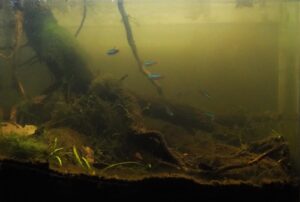A Small Tributary Of The Ucayali River, Requena, Peru
_st place in Biotope Aquarium Design Contest 2022

Volume of aquarium: 28 liters
Dimensions of aquarium: 40x25x28h
List of fishes: Paracheirodon innesi
List of plants: Vesicularia montagnei, Sagittaria subulata.
Description of Decorations and Substrate: There is driftwood and plenty of dry leaves used for sediment formation. Mosss, algae and subulata plants were used to create the small pond floor.
Description of Equipment: Waterfall filter, 50 w heater, 12 watt 6K led lighting.
Water Parameters: 25 °C temperature, 6.8 pH, 5 gH, 2 kH.
Additional Info: A weekly 20% routine water change is applied.
Aquarium video:
https://disk.yandex.com.tr/i/EErIRJLEZuAiAw
Description of the Area Surrounding the Biotope: The Ucayali River (Spanish: Río Ucayali, IPA: [ˈri.o ukaˈʝali]) is the main headstream of the Amazon River. It rises about 110 km (68 mi) north of Lake Titicaca, in the Arequipa region of Peru and becomes the Amazon at the confluence of the Marañón close to Nauta city. The city of Pucallpa is located on the banks of the Ucayali.
The Ucayali, together with the Apurímac River, the Ene River and the Tambo River, is today considered the main headwater of the Amazon River, totaling a length of 2,669.9 kilometres (1,659.0 mi) from the source of the Apurímac at Nevado Mismi to the confluence of the Ucayali and Marañón Rivers:
The Ucayali was first called San Miguel, then Ucayali, Ucayare, Poro, Apu-Poro, Cocama and Rio de Cuzco. Peru has organised many costly and ably-conducted expeditions to explore it. One of them (1867) claimed to have reached within 380 km (240 mi) of Lima, and the little steamer “Napo” found its way up the violent currents for 124 km (77 mi) above the junction with the Pachitea River, and as far as the Tambo River, 1,240 km (770 mi) from the confluence of the Ucayali with the Amazon. The “Napo” then succeeded in ascending the Urubamba River 56 km (35 mi) upstream from its junction with the Tambo, to a point 320 km (200 mi) north of Cuzco.
Description of the Underwater Landscape of the Biotope: In the rainy season, river flooding that creates small ponds creates a misty water appearance. The pond floor is covered with dense sediment formed by dry leaves, tree branches and decomposing organic materials. Large and small stones and a layer of white fine sand are also seen on the ground.
Description of the Habitat Parameters: The water is slightly misty and tannin-stained, the temperature is 23-29 °C throughout the year. The seasonal water parameters are as follows: 0-100 ppm TDS, 4.5-7.0 .
List of Fishes and Invertebrates Occurring in the Nature Biotope: Corydoras trilineatus, Copella nattereri, Carnegiella Hatchetfish, Carnegiella strigata, Paracheirodon innesi, Nannostomus trifasciatus, Thayeria boehlkei, Hyphessobrycon frankei, Hyphessobrycon loretoensis, Hyphessobrycon peruvianus, Moenkhausia margitae, Crenicara punctulatum, apistogrammoides pucallpaensis, Apistogramma cacatuoides, Apistogramma agassizii, Apistogramma cf. eunotus, Apistogramma njisseni, Planiloricaria cryptodon, Otocinclus cocama, Ancistrus sp
List of Plants Found in the Nature Biotope: Pistia stratioides, Limnobium laevigatum, Eleocharis parvula, Mayaca filuviatilis, Sagittaria subulata, Vesicularia montagnei.
Threats to the Ecology of the Biotope: Considered one of the “mother” rivers of the amazon river, the Ucayali and its biotopes (as well as some rivers of the Amazon basin) are in degradation. The construction of large water dams, the rampant exploration of oil, the extraction of precious / heavy metals, and even the local capture and fishing of the riverside inhabitants when uncontrolled and conscious, slowly annihilates the local population of the specimens.
Sources of Information:
https://en.wikipedia.org/wiki/Ucayali_River
https://www.britannica.com/place/Ucayali-River
https://blog.ameba.jp/reader.do?bnm=apfarmk
